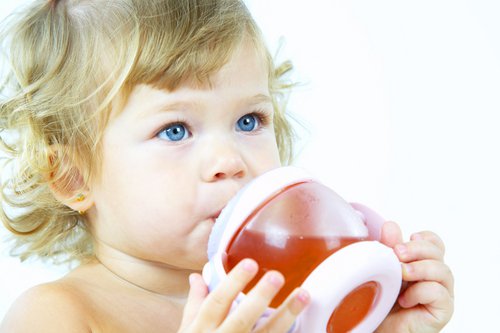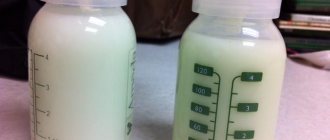For the mother, any kind of breast refusal is a concern. At this moment, the baby may be very capricious, cry, turn away and bend in every possible way. The woman is advised to change position and try to continue feeding. She must try to cope with the nervous state, internal anxiety, because otherwise the baby will remain completely hungry.
A child refuses breastfeeding for various reasons. This can be caused by illness, poor feeding habits, and stressful situations. If the main errors are eliminated in the shortest possible time, the child will be able to drink his mother's milk again without hindrance.
The main reasons for a baby's refusal to breastfeed
The baby is incredibly sensitive to all external factors. He feels his mother’s bad mood and malaise. Additional obstacles to continued feeding may include increased body temperature, pain, and an unpleasant taste in the mouth.
Doctors have long wondered why a child refuses breast milk? A pacifier is considered to be a negative factor. The process of sucking it is different from the breast. The baby thus becomes lazier when it comes to getting food. He doesn't want to spend extra effort sucking the breast on his own.
Milk may suddenly rush into a woman's breasts. In this case, the baby can no longer cope with the influx of volume and even choke. The situation is typical for the first few months after the baby is born. During this period, lactation cannot yet be fully established.
Breast refusal may be due to stress
Stress negatively affects not only the mother’s well-being, but is also transmitted to the baby. An infant experiences depression in the following cases:
- Parents thought too early about the need to harden their child.
- A stressful situation occurs if the baby unexpectedly dives under water while swimming.
- A visit to any doctor has a negative impact on the general emotional state of the child, and therefore may lead to breast refusal.
The process of personal hygiene plays an important role. The baby instantly reacts to an unpleasant smell. Mommy should take him in her arms more often: in this case, a strong emotional connection is established between them. Otherwise, the baby develops mistrust, which can subsequently lead to refusal.
The feeding process itself must proceed correctly. Mother and baby should be in comfortable conditions. For a good flow of milk, the newborn must grasp not only the nipple, but also the areola. If your child begins to be very naughty, you should do the following:
- The woman takes him in her arms and does not let go until he calms down.
- The areola can be lightly lubricated with milk and pressed with your fingers. In this position, it will be convenient for the baby to begin the process of absorbing food.
- The baby's mouth should not slide only to the nipple.
A baby may refuse to breastfeed if it is too full. To prevent this situation, it is recommended to express some milk first.
The baby cannot comfortably take an elongated, flat or small nipple into his mouth. A special overlay or manual straightening of the nipple anatomy can solve this problem.

A woman should take a comfortable position
It is not uncommon for children to refuse only one breast. To resume feeding you must:
- establish the main causes of the negative consequences of the process;
- do not stop offering this breast to the baby (periodically change the position, give to a sleepy person or after playing);
- a woman must understand that one breast is enough for feeding.
A woman's breast milk is divided into two types: anterior and posterior. The first option contains many vitamins and minerals that are beneficial to the body. The second contains more calories, so it can be difficult for the baby to suck it completely.
What to do if your baby is lazy:
We recommend reading: Why a newborn does not get enough breast milk
- Before your next meal, you need to thoroughly massage your breasts.
- While your baby is eating, you should also continue simple massaging. In this case, the remaining liquid will come closer to the nipple.
- If a child asks for a second breast, then the woman should be sure that this one is completely empty. Foremilk is low in fat, so babies are at risk of poor development and weight gain. Excessive fat content in milk is also observed if a woman does not follow nutritional rules. You should eat meat, milk, cottage cheese, cheese, butter and nuts in acceptable quantities.
- Pay attention to reviewing basic nutrition rules.
- In the hot season, a woman’s body may not have enough moisture, so milk contains more fat than in winter.
- The drinking regime depends on the air temperature, so it should be adjusted depending on this aspect.
A one-month-old baby, unlike an adult, has several hundred receptors on the tongue. Thanks to them, he can feel the slightest changes in the taste of breast milk. It can be spoiled by onions, garlic, cabbage. The mother should exclude hot spices and radishes from her diet. As a rule, these foods are not to the baby's liking.
Medications also have a negative effect. To prevent the situation, you should adhere to a number of basic rules:
- Completely exclude from the diet foods that the child does not like.
- You can only take medications that have been approved by your doctor. Don't breastfeed unless you are sure it's right. Medicines can not only spoil the taste of a dairy product, but also harm the child’s health.

When supplementary feeding is introduced, breast refusal may follow
Quite often, a baby does not want to eat if he smells an unusual smell. They must always be in the same conditions. This is why children cannot suckle on another woman's breast. Refusal may follow even if mommy starts using a new perfume or deodorant. In this case, the woman is recommended:
- Take a shower with soap that can mask the unpleasant odor. The procedure may need to be repeated several times.
- Remove clothes that have become saturated with the new smell.
What to do if your child does not eat dairy products?
Before taking any measures to introduce dairy products into a child’s diet, it is necessary to find out the reason for the refusal. In case of food allergies, you will have to avoid using them altogether. Goat or soy milk can be used as a substitute. In terms of taste, they are as close as possible to cow's, but the chemical composition is significantly different. Even if you are allergic to cow's milk protein, you can safely give fermented milk products; the protein in them is partially denatured.
In case of individual intolerance, similar recommendations should be followed. It is better to wait up to three years with whole milk. In this case, it is necessary to strictly monitor the child’s reaction and monitor his well-being.
Behavioral tactics when a child refuses dairy products related to taste preferences can be varied, and there are several universal tricks.
For bottle-fed babies, it is recommended to pour dairy products into a regular feeding bottle. Children often form associations - a familiar feeding bottle will contain only tasty and healthy food.
All kids love sweets, and rarely do they refuse fruit purees. Babies can be given natural yoghurts and kefir without additives, but at home they can be mixed with your favorite fruit puree. The resulting taste will be unusual, but quite pleasant for the child.
You can sweeten milk and its derivatives with jam, small pieces of sweet fruits or dried fruits, honey - but only in the absence of an allergy or predisposition to it, because honey is a strong allergen.
Cottage cheese and sour cream can be used as sauces or components of dishes, for example, various casseroles and baked goods. Few kids will refuse juicers, cheesecakes, seasoned with sour cream and sugar or pieces of their favorite fruit. Creative and interesting presentation of the dish will help stimulate your appetite. It is important to remember that not only the taste of a dish is important for a child, but also its appearance.
Try adding dairy products to your child’s already familiar dishes, for example, add a little cheese to meatballs or cutlets, or make mashed potatoes with milk. When baking, you can use sour cream and cheese. Children usually like cheese melted or crusted.
Refusal to breastfeed at the very beginning of feeding
You should not worry when your baby acts restless just before the feeding process begins. In this case, only a false refusal can follow. The baby needs some time to adapt and learn to eat properly. At the same time, he may shake his head and have difficulty grasping the nipple. The situation usually goes away by the second month. For the first four weeks, the mother should do her best to help the baby grasp the nipple correctly and point his head in the right direction.
In addition to breast milk, the baby's diet should include complementary foods. From the age of four months, he begins to actively explore the world around him. During the feeding process, he can be distracted by any extraneous noise or sound. A woman must understand that this is not a refusal to breastfeed, but an attempt to look at everything around her.
There is no connection between the child and mother
The baby constantly cries and shows his dissatisfaction if he does not have proper contact and communication with his mother. In this case, she should reconsider the interaction scheme. You should not strictly adhere to the feeding schedule, because in this case the baby may not eat enough. The situation may arise if a woman needs to be absent for a long time. In this case, the psychological connection may be disrupted. Due to lack of food and attention, the baby feels severe irritation and discomfort. The situation is dangerous due to the occurrence of failures during further breastfeeding.
Stress is transmitted to the child during feeding. That is why mommy is advised to monitor her emotional state. The child should feel protected. In this case, breastfeeding will take place for a long time.

A bottle is an easy way to get food
Ways to overcome failure
From time to time, a woman is faced with the question of what to do to restore her previous feeding? At the first stage, it is necessary to establish the cause of the process. A breastfeeding specialist can help parents with this.
The situation may arise after bottle feeding or introduction of complementary foods. Refusal can be avoided if supplementary feeding is done using a syringe. There are also special spoons for infants for this purpose.
Milk flow decreases if a woman is in an uncomfortable position. It is recommended to change it. For example, lie on your stomach. If necessary, you can pause during the feeding process. Mixtures should be added last.
If it has been determined that the child does not want to breastfeed due to stress, then the most comfortable conditions should be created for him. It is important to avoid his diving during the bathing process and stop hardening for a while. It will be possible to return to the previous rhythm only after the lactation process has normalized. On average, this can take three to four weeks. It all depends on the individual characteristics and psycho-emotional state of the child.
If parents detect the first signs of subsequent refusal, then they should increase attention to the baby. Refuse outside help and spend more time with your child. The mother is advised to regularly pick him up and put him to sleep with her. You should avoid visiting guests for a while. Bathing the baby with the mother also has a positive effect.

If you follow all the rules, the feeding process will quickly recover
The child should know that he can receive the breast at any time. You shouldn't stick to a specific pattern. The baby consumes a large volume of breast milk before bedtime. Parents should not limit him in this. It is recommended to offer him the breast immediately after waking up. In this case, all the kids happily start eating.
A woman is advised to follow all the rules exactly. In this case, it will be possible to normalize nutrition within two weeks. During the recovery period, the child should have access to the breast every hour. After training is completed, the feeding process will be shortened several times.
If the child does not want to drink the formula, what should the mother do?
- Choose a different mixture. If the child does not want to drink the formula, then you need to try to find another formula for him, from other manufacturers. Do you need to find out why the child does not drink the formula? Maybe some components are not suitable for him and even cause allergies.
- Warm the mixture as you would breast milk. If the formula is too hot or cold, the child will refuse to drink it; it is also necessary to check the temperature of the mixture each time before feeding the baby.
- Show your child a living example. Every child will eat what his mother eats. That is why sometimes a natural example of imitation next to a child is important. If the mother eats with the child, the baby will also eat the same food.
It is imperative to understand the reasons for a child’s refusal to drink water, milk or formula. Another reason is a painful state of health, here teeth can erupt, tummy ache, intestinal upset, etc.
The need for mixed nutrition
If a child constantly refuses to breastfeed, then at the next examination a lack of weight may be detected. To fix the problem, you need to determine whether it is receiving enough power. It is recommended to regularly count the number of urinations. Doctors say that they should not be less than seven times a day. The advisability of introducing supplementary feeding is influenced by many factors. It is not necessary to introduce it right away.
The baby should receive additional nutrition if there is poor weight gain and insufficient urination. In this case, the question of a mixed feeding option is considered. In this case, the child will be able to receive the required amount of vitamins and minerals from the artificial version. The choice of product and feeding intensity is selected by a pediatrician based on examination data.
The child refuses to drink milk, what should I do?
If a child refuses to drink breast milk and refuses his mother's breast, it is necessary to understand why this is happening. How to teach a child to drink? The main thing is not to panic. We need to see if the mother doesn’t hold the baby comfortably while feeding, and this gives him discomfort. You also need to watch how the baby grasps the breast; he must grasp the nipple and the areola with his mouth for proper latching. At the same time, when the child eats, there should be no loud whistling or smacking; this means the child is sucking air, not milk. Nothing should distract the child from drinking. These are neither sounds nor noises, TVs, music, etc. If the mother does not have milk or has lost it for some reason, then the child can be given an artificial formula.










